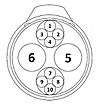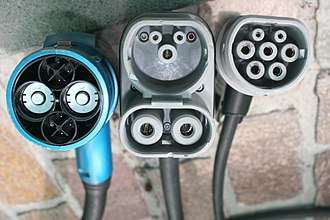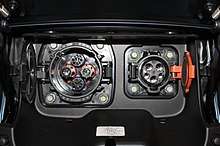CHAdeMO
CHAdeMO is the trade name of a quick charging method for battery electric vehicles delivering up to 62.5 kW by 500 V, 125 A direct current[1] via a special electrical connector. A revised CHAdeMO 2.0 specification allows for up to 400 kW by 1000 V, 400 A direct current.[2][3]
 | |
 Charging station plug | |
| Formation | 2010 |
|---|---|
| Purpose | CHAdeMO Association aims to create the optimal fast charging standard in order to accelerate the realisation of e-mobility globally. |
| Website | chademo |

It was proposed in 2010 as a global industry standard by an association of the same name formed by five major Japanese automakers[4] and included in the IEC61851-23, -24 (charging system and communication) and the IEC 62196 standard as configuration AA. Competing standards include the Combined Charging System (CCS)—used by most German and US automakers[5]—and the Tesla Supercharger.
CHAdeMO is an abbreviation of "CHArge de MOve", equivalent to "move using charge" or "move by charge" or "charge 'n' go", a reference to the fact that it's a fast charger. The name is derived from the Japanese phrase O cha demo ikaga desuka, translating to English as "How about a cup of tea?", referring to the time it would take to charge a car.[4] CHAdeMO can charge low-range (120 km, or 75 mi) electric cars in less than half an hour. As of June 2018, CHAdeMO allows up to 400 kW of charging (400A x 1kV) and aims for 900 kW as it is currently co-developing with China Electricity Council (CEC) the next-generation ultra-high-power charging standard with the working name of “ChaoJi.”[6]
History
The CHAdeMO Association was formed by the Tokyo Electric Power Company (TEPCO), Nissan, Mitsubishi and Fuji Heavy Industries (now Subaru Corporation). Toyota later joined as its fifth executive member, followed by Hitachi, Honda and Panasonic.[7][8][9] CHAdeMO Research and Development started in 2005 with the goal of developing a public infrastructure of fast chargers that enables people to drive EVs without worrying about the range of their battery. The first commercial CHAdeMO charging infrastructure was commissioned in 2009 and CHAdeMO was published as IEC standards in 2014 (IEC 61851-23 for charging system, 61851-24 for communication, and IEC 62196-3 configuration AA for connector). In the same year, CHAdeMO was published as EN standard, followed by the publication as IEEE Standard 2030.1.1TM-2015 in 2016.
In Europe, the European Commission has submitted in 2013 a proposal for the Alternative Fuels Infrastructure Directive designating the Combo2 (IEC61296-3, configuration FF) as the European mandated plug for DC high-power charging. While the European Parliament adopted a draft report supporting CHAdeMO to be "transitioned out by January 2019," at the final stage of law-making this was rejected and the final version (EU Directive 2014/94/EU) simply mandates all publicly accessible chargers in the EU to be equipped "at least" with Combo2 connectors, endorsing explicitly multistandard charging in Recital 33. There is no conflict with European Directive 2014/94/EU regarding barriers. Charging stations with several charging interfaces are explicitly permitted.[10]
By December 2015, the CHAdeMO network had reached 10,000 charge points worldwide in 50 countries: 5,974 in Asia, 2,755 in Europe, and just 1,400 in North America.[11]
By July 2017, the CHAdeMO Association web site stated that the number had grown to over 16,000 CHAdeMO chargers installed globally, still mostly located in Japan (≈7,100+). Europe had over 4,600, North America had more than 2,200 and 2,000 were located elsewhere.[12]
In 2018 the total number of the charge points in Europe surpassed that of Japan.[13] As of April 2019, there were roughly 25,300 CHAdeMO charge points globally, with the biggest share, 9,200, in Europe, 7,600 in Japan, 3,200 in North America and more than 5,300 elsewhere.[14]
In July 2020, Nissan unveiled the new 2021 Nissan Ariya to the US market, and it will have only a CCS charge port rather than the CHAdeMO port that had been on the Nissan Leaf the previous ten years. Auto analysts noted that, with this decision to abandon CHAdeMO charging, it is the "death knell" for CHAdeMO in the US and Europe, as it will leave only the Mitsubishi Outlander plug-in hybrid as the one new car in the US using CHAdeMO. "The plug wars are over. CCS won. We're going to see some consolidation."[15]
DC fast charging
Most electric vehicles (EVs) have an on-board charger that uses a rectifier circuit to transform alternating current from the electrical grid (mains AC) to direct current (DC) suitable for recharging the EV's battery pack. Cost and thermal issues limit how much power the rectifier can handle, so beyond around 240 V AC and 75 A it is better for an external charging station to deliver DC to the battery. Given these limits, most conventional charging designs are based on 240 V, 30 A in the United States and Japan, 240 V, 40 A in Canada and 230 V, 15 A or 3Φ, 400 V, 32 A in Europe and Australia. AC chargers with higher limits have been specified, for example SAE J1772-2009 has an option for 240 V, 80 A and VDE-AR-E 2623-2-2 has 3Φ, 400 V, 63 A. But these charger types have been rarely deployed in the US and only EVs made by Tesla have a matching rectifier.
For faster charging, dedicated chargers can be built in permanent locations and provided with high-current connections to the grid. In this style of connection, the charger's DC output has no effective limit, theoretical or practical. Such high voltage and high-current charging is called a DC fast charge (DCFC) or DC quick charging (DCQC).[16]
CHAdeMO originated out of Tokyo Electric Power Co.'s charging system design. TEPCO had trialled numerous EV infrastructure projects between 2006 and 2009 in collaboration with Nissan, Mitsubishi and Subaru (amongst others).[17] These trials resulted in developing patented technology and a specification for high-voltage (up to 500 V DC) high-current (125 A) automotive fast charging via a Japan Automobile Research Institute (JARI) DC fast-charge connector,[18] which is the basis for the CHAdeMO protocol.[19] The connector was specified by the 1993 Japan Electric Vehicle Standard (JEVS) G105-1993 from the JARI.[20]

In addition to carrying power, the connector also makes a data connection using the CAN bus protocol.[21] This performs functions such as a safety interlock to avoid energizing the connector before it is safe (similar to SAE J1772), transmitting battery parameters to the charging station including when to stop charging (top battery percentage, usually 80%), target voltage, and total battery capacity, and while charging how the station should vary its output current.[22]
Vehicle-to-grid integration (VGI) or Vehicle-to-Grid (V2G)
CHAdeMO has published its V2X protocol in 2014 and as of August 2019, CHAdeMO remains the only standardised charging protocol that defines V2X and has mass-produced cars and chargers (PCS or power conditioners) readily capable of it.[23] V2G technology enables EV owners to use the car as an energy storage and to save costs by optimising energy usage and providing services to the Grid.[24] Since 2012, multiple V2X demo projects using V2X capacities of CHAdeMO protocol have been going on around the world. Some of the recent projects include UCSD INVENT[25] in the United States, as well as Sciurus and e4Future[26] in the United Kingdom that are supported by Innovate UK.
High-power charging
CHAdeMO has published its protocol for 400 kW ‘ultra-fast’ charging in May 2018.[27] This CHAdeMO 2.0, delivering a 400 kW output, allowed the standard to better compete with the CCS “ultra-fast” stations being built around the world as part of new networks such as IONITY charging consortium.[28]
In August 2018, CHAdeMO Association has announced co-development of the next-generation ultra-high-power plug with CEC (China Electricity Council),[29] with which CHAdeMO will harmonise. This project with the code name ChaoJi aims to enable 900 kW (600A x 1.5kV), all the while ensuring backward compatibility with the current CHAdeMO and GB/T (IEC 62916-3 configuration BB) chargers, according to the Association. It was revealed that ChaoJi can also be made backward compatible with CCS and such study is under consideration as of summer 2019.[30]
In the meantime, high-power CHAdeMO charging technology is also advancing. High-power CHAdeMO stations are being constructed in North America as well as in Europe since 2018. In July 2019, UL has issued a certification to UL 2251 to accommodate CHAdeMO's "boost mode" high-power charging using a non-cooled cable assembly.[31]
Deployment
In charging stations
CHAdeMO-type fast charging stations have initially been installed in great numbers by the utility TEPCO in Japan, which required the creation of an additional power distribution network to supply these stations.[32] Since then, CHAdeMO charger installation has expanded its geographical reach and in April 2019, the CHAdeMO Association stated that there were 25,300 CHAdeMO chargers installed in 71 countries. These included 7,600 charging stations in Japan, 9,200 in Europe, 3,200 in North America, and 5,310 elsewhere.[33]
| Country | Stations | |||
|---|---|---|---|---|
| 2017[35] | May 2015 | March 2012 | March 2011 | |
| 40[36] | 5 | 1 | ||
| 170 | 29 | 3 | ||
| 9 | 2 | |||
| 58 | 39 | 3 | ||
| 10[36] | 2 | |||
| 20[36] | ||||
| 7[36] | 5 | 1 | ||
| ≈290 | 44 | 4 | ||
| 50 | 10 | |||
| 126 | 59 | 3 | ||
| 148 | 163 | 148[37] | ||
| 58 | 33 | |||
| 350 | 214 | 9 | ||
| 1 | 1 | |||
| 620 | 113 | 18 | ||
| 40[36] | 7 | 11[38] | ||
| 28 | 12 | 1 | ||
| 22 | 13 | 8 | ||
| 80 | 67 | 19 | ||
| 65 | 14 | 1 | ||
| 5484 | 980 | 582 | ||
| 70 | 70 | |||
| 4 | 3 | |||
| 182 | 3 | |||
| 3 | 2 | 1 | ||
| 10[36] | 2 | |||
| 140 | 495[39] | 21 | ||
| 86[36] | 2 | 2 | ||
| 450 | 171 | 16 | ||
| 35 | ||||
| 60[36] | 18 | 18 | ||
| 36[36] | 19 | 3 | 1 | |
| 52[36] | 2 | 4 | ||
| 32[36] | ||||
| 159[36] | 105 | 6 | ||
| 42[36] | 25[40] | 0 | ||
| 205 | 83 | 5 | ||
| 124 | 57 | 4 | ||
| 1 | 1 | 1 | ||
| 869[41] | 291 | 36 | ||
| 162[42] | >6[43] | 4[43] | ||
| 1677[44] | 1337 | 355+[45] | ||
West Coast Electric Highway
The West Coast Electric Highway[46] (WCEH) is an extensive network of electric vehicle (EV) DC fast charging stations located every 25 to 50 miles along Interstate 5 and other major roadways in the Pacific Northwest of the United States.
The build out of the WCEH began in 2010 with the deployment of CHAdeMO and level 2 charging stations. As of 2014, a network with thousands of level 2 charging pedestals and dozens of DC fast chargers including both Combined Charging System and CHAdeMO.
Manufacturers
As of July 2019, a total of 260 certified CHAdeMO charger models have been produced by 50 companies.
In the early times, in the United States, Aker Wade Power Technologies has entered into a licensing agreement with TEPCO to manufacture and market DC fast chargers for electric vehicles.[18] Eaton Corporation has demonstrated a CHAdeMO-compatible DC quick charger[47] recharging Mitsubishi iMiEV cars.[48] ECOtality has deployed the Blink DC Fast Charger, which is outfitted with two CHAdeMO-compliant electric vehicle charging connectors, in the Blink Network.[49] AeroVironment offers a broad line of DC fast chargers including two CHAdeMO certified Quick Charger models. Princeton Power Systems' UL-certified (2202 and 1741) bi-directional CHAdeMO charger fast-charger is capable of charging and discharging from the Nissan LEAF, for both grid-tied and backup-power modes. The fast-chargers are available in 10 kW, 15 kW, and 30 kW sizes. Fuji Electric Corporation of America announced a 25 kW CHAdeMO quick charger[50] integrated with Coulomb Technologies' ChargePoint Network.[51] ABB manufactures 50 kW and 20 kW CHAdeMO models with UL certification for the Americas markets.
Andromeda Power has a mobile DC CHAdeMO 50 kW charger.[52]
In Europe, Evtronic,[53] Schneider-Electric, SGTE Power,[54] CIRCONTROL (Spanish manufacturer), ABB, formerly Epyon,[55]GH EverDrive and Efacec were the first European companies get CHAdeMO certification and make fast chargers equipped with the latest CHAdeMO communication protocol.
Polar Power Inc. has developed mobile electric generators for charging electric cars.[56]
In Canada, AddÉnergie Technologies and Elmec design and manufacture fast-charging stations that support both CHAdeMO and SAE.
In vehicles
The CHAdeMO quick charge option was promoted by Nissan-Renault and it has found acceptance with Japanese car manufacturers to allow their electric cars to benefit from the CHAdeMO charger network in Japan. With over 20 OEMs, in 2018 CHAdeMO chargers continued to serve the biggest share (44%) of the fast-chargeable pure battery electric vehicles (BEVs) in the world.[57] Models supporting CHAdeMO charging include:
- Arrival van
- Bollinger B1
- BMW i3 (Japan only)
- Citroën C-ZERO
- Citroën Berlingo Electric/E-Berlingo Multispace
- GLM Tommykaira ZZ EV
- Honda Clarity PHEV (Japanese model only)
- Honda Fit EV
- Hyundai Ioniq Electric (2016)
- Kia Soul EV
- LEVC Tx
- Mazda Demio EV
- Mitsubishi Fuso eCanter
- Mitsubishi i MiEV
- Mitsubishi MiEV truck
- Mitsubishi Minicab MiEV
- Mitsubishi Outlander P-HEV
- Nissan LEAF
- Nissan e-NV200
- Peugeot iOn
- Peugeot Partner EV
- Peugeot Partner Tepee
- Subaru Stella EV
- Tesla Model 3 (adapter optional for North American and Japanese models[58]; not supported in cars that have integrated CCS capability.)
- Tesla Model S (via included adapter in Japan; adapter optional in other countries[58])
- Tesla Model X (via included adapter in Japan; adapter optional in other countries)
- Tesla Model Y (adapter optional for North American and Japanese models[58]; not supported in cars that have integrated CCS capability.)
- Toyota eQ
- Toyota Prius Prime (Japan only)
- Toyota RAV4 EV First Generation 2001-2003 (with after-market add-on)
- Toyota RAV4 EV Second Generation 2012-2014 (with after-market add-on)
- Zero Motorcycles (via optional inlet)
- Vectrix VX-1 Maxi Scooter (via optional inlet)
Quick Charge Power of San Diego plans to offer CHAdeMO retrofits for the second generation Toyota RAV4 EV and the Mercedes B-Class starting in 2015.[59]
Gallery
 TEPCO Quick Charging Pedestal
TEPCO Quick Charging Pedestal A charging site in Quebec, featuring an AddÉnergie Technologies 50 kW CHAdeMO/CCS Combo DC fast charger and a L2 EVSE.
A charging site in Quebec, featuring an AddÉnergie Technologies 50 kW CHAdeMO/CCS Combo DC fast charger and a L2 EVSE. Multistandard charger example
Multistandard charger example multistandard charger example2
multistandard charger example2 CHAdeMO plug
CHAdeMO plug
References
- http://www.fveaa.org/fb/Level3Charging_279.pdf
- "CHAdeMO releases the latest version of the protocol enabling up to 400KW".
- "Protocol Development – Chademo Association". Retrieved 2019-07-31.
- "General Outline of "CHAdeMO Association"" (PDF) (Press release). TEPCO. 2010-03-15. Retrieved 2010-05-13.
- "DC fast-charging in east, west coast corridors done, say VW, BMW". Green Car Reports. 14 September 2016. Retrieved 20 April 2019.
- "CHAdeMO to jointly develop next-gen Ultra-Fast Charging Standard with China". Chademo Association. Retrieved 2019-07-31.
- "Establishment of CHAdeMO Association" (Press release). TEPCO. 2010-03-15. Retrieved 2010-05-13.
- Chuck Squatriglia (2010-03-16). "Let's Have Tea While Charging Our EV". Autopia. Wired.com. Retrieved 2010-05-13.
- "History & Timeline – Chademo Association". Retrieved 2019-07-31.
- Eickelmann, Jens (2017). Driving Force Electromobility. Schieder, Germany: Phoenix Contact E-Mobility GmbH. p. 105. EMO03-17.000.L6.
- "CHAdeMO : History & Timeline". Retrieved April 20, 2019.
- "CHAdeMO official website". Retrieved April 27, 2016.
- "CHAdeMO crossed the global 20k mark with Europe leading in installation". Chademo Association. Retrieved 2019-07-31.
- "CHAdeMO Association & Protocol" (PDF). CHAdeMO Brochure. April 2019.
- Nissan Takes on Tesla, E for Electric, at 7:27, 19 July 2020, accessed 21 July 2020.
- Dhawad, Kushal (June 2017). "Charging connectors for Electric Vehicles at charging stations". International Journal of Recent Engineering Research and Development (IJRERD). 02 (6): 35–38 – via IJRERD.
- Tillemann, Levi (2015). The Great Race: The Global Quest for the Car of the Future. New York, NY 10020: Simon & Schuster. pp. 131–133. ISBN 978-1-4767-7349-0.CS1 maint: location (link)
- "Tokyo Electric Power Licenses Aker Wade to Build Level III DC Fast Chargers". Green Car Congress. 2010-01-15. Retrieved 2010-04-13.
- "Exclusive interview with the CEO of Aker Wade: "Standardisation is the key"". cars21.com. 2010-04-29. Retrieved 2010-05-13.
- "Nissan Introduces Quick EV Charger" (Press release). Nissan. 2010-05-21. Archived from the original on 2010-05-24. Retrieved 2010-05-21.
- "Technology Overview – Chademo Association".
- Takafumi Anegawa (2010-12-01). "Safety Design of CHAdeMO Quick Charger and its impact on Power Grid" (PDF). TEPCO. Retrieved 2011-01-25.
- "V2G report published identifying 50 projects around the world". Chademo Association. Retrieved 2019-08-21.
- "V2X – Chademo Association". Retrieved 2019-08-21.
- "UC SAN DIEGO EXPANDS TRITON RIDES PROGRAM WITH VEHICLE-TO-GRID SERVICE FROM NUVVE". NUVVE Corp. 2018-10-30. Retrieved 2019-08-21.
- "e4Future V2G - National Centre for Energy Systems Integration - Newcastle University". www.ncl.ac.uk. Retrieved 2019-08-21.
- "CHAdeMO releases the latest version of the protocol enabling up to 400KW". Chademo Association. Retrieved 2019-08-21.
- "CHAdeMO is pushing for faster electric vehicle charging with new 400 kW protocol". 2018-06-15.
- "CHAdeMO to jointly develop next-gen Ultra-Fast Charging Standard with China". Chademo Association. Retrieved 2019-08-21.
- "1st International ChaoJi Technical Workshop in Tokyo". Chademo Association. Retrieved 2019-08-21.
- "UL Contributes To Expansion of e-Mobility by Issuing Safety Certification to Sumitomo Electric Industries, Ltd". UL. Retrieved 2019-08-21.
- André P. Slowak (2012-06-27). "Die Durchsetzung von Schnittstellen in der Standardsetzung: Fallbeispiel Ladesystem Elektromobilität" (PDF). Fzid Discussion Papers (in German). Universität Hohenheim, Forschungszentrum Innovation und Dienstleistung: 29. ISSN 1868-0720. Archived from the original (PDF) on 2015-10-23. Retrieved 2012-07-19.
Die deutsche Industrie greift auf das herkömmliche Stromverteilernetz zurück. Tepco hingegen hat für CHAdeMO ein eigenes Verteilernetz aufgebaut.
- "Chademo Association – EV Fast Charging Organisation". Retrieved 2019-08-21.
- André P. Slowak (2012-06-27). "Die Durchsetzung von Schnittstellen in der Standardsetzung: Fallbeispiel Ladesystem Elektromobilität" (PDF). Fzid Discussion Papers (in German). Universität Hohenheim, Forschungszentrum Innovation und Dienstleistung: 36. ISSN 1868-0720. Archived from the original (PDF) on 2015-10-23. Retrieved 2012-07-19.
Tabelle 8: Installierte Basis CHAdeMO (Stand: Juni 2012) Datenquellen: CHAdeMO (2011, 2012a, 2012b).
- "Stromtankstellen Statistik | GoingElectric.de". goingelectric.de. Retrieved 2017-12-17.
- "PlugShare - EV Charging Stations Map".
- "Euroopa Liit tahab kehtestada Eestile sobimatut elektriauto kiirlaadija standardit". 2013-01-24.
- "Promotion of Electric Vehicles in Hong Kong | Environmental Protection Department".
- At the end of 2015 (http://www.rvo.nl/onderwerpen/duurzaam-ondernemen/energie-en-milieu-innovaties/elektrisch-rijden/stand-van-zaken/cijfers)
- http://www.green-frontiers.net/
- "Map of charging points for electric car drivers in UK: Zap-Map". Zap-Map. Retrieved 2018-01-24.
- "Autoenterprise EV Charge Network".
- Аналитика: динамика развития электро-заправочных станций в Украине, 11 of June 2016, autogeek.com.ua
- "2017 Update: Geographic Distribution of DC Fast Chargers | PlugInSites - EV Charging Stations". PlugInSites - EV Charging Stations. 2017-09-12. Retrieved 2017-12-17.
- "Alternative Fuels Data Center: Alternative Fueling Station Locator".
- "West Coast Green Highway: West Coast Electric Highway".
- Erin Milnes (2010-09-10). "With Electric Cars Soon to Arrive, Where Is Charging Headed?". The Solar Home & Business Journal. Retrieved 2010-09-29.
- "Eaton Charging Stations Showcase Electric Vehicle Infrastructure at Plug-In 2010" (Press release). Eaton Corporation. 2010-07-20. Retrieved 2010-09-29.
- "Blink EVSE Products". ECOtality. 2013-07-02. Retrieved 2013-07-02.
- "DC Quick Charger For Electric Vehicles" (PDF). Fuji Electric. 2012-03-06. Retrieved 2012-05-17.
- "Fuji Electric Announces Agreement With Coulomb Technologies" (Press release). Fuji Electric & Coulomb Technologies. 2012-05-01. Retrieved 2012-05-17.
- "Andromeda Power (ORCA Mobile)". Andromeda Power Corporation. 2012-04-03. Retrieved 2012-04-03.
- "Evtronic make fast chargers compliant with CHAdeMO communication protocol" (Press release). Evtronic. 2010-07-02. Retrieved 2010-07-02.
- "SGTE Power makes CHAdeMO EV Quick Chargers" (Press release). SGTE Power. 2010-07-13. Retrieved 2010-07-13.
- "Epyon Joins International Group for Fast Charging Standard" (PDF) (Press release). Epyon. 2010-04-15. Retrieved 2010-05-13.
- "Mobile Rapid Battery Charging for Electric Car Applications". 2010-07-07.
- "CHAdeMO vehicle stats". Chademo Association. Retrieved 2019-08-21.
- "CHAdeMO Adapter".
- "One Year On: My Life with the Toyota Rav4 EV Electric Car (Part 2 of 3)". 2014-05-30.